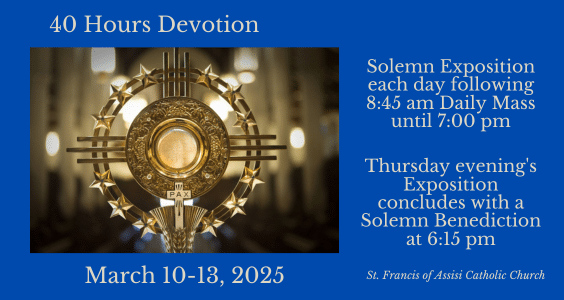40 Hours Devotion
Eucharistic Adoration
St. Francis of Assisi parish will hold a 40 Hour Eucharistic Devotion beginning with morning Mass on March 10th and closing with a solemn Benediction on Thursday early evening, March 13th. The Forty Hours Devotion can be celebrated either in 40 continuous hours, or based on the needs of the local parish, can be broken into daily celebrations. Here at St. Francis, we have elected to do the latter.

Use the buttons below to sign up to spend 1 hour with devotion and adoration of the Blessed Eucharist
The daily schedule is:
- Morning Mass (8:45 am)
- Exposition of the Blessed Sacrament (from after morning Mass until 7:00 pm each day).
- Hour long segments with extended periods of silence. Materials in support of prayer will be available.
- Each day will close with the Repose of the Blessed Sacrament at 7:00 pm
- On Thursday the closing Benediction begins at 6:15 pm
The Forty Hours Devotion is an opportunity to gather as a community before the Blessed Sacrament and to pray before the Lord in adoration. It gives us time to deepen our appreciation of the importance of the mystery of the Eucharist in our lives. Traditionally it begins with a celebration of Mass. At the end of this opening Mass the Blessed Sacrament is exposed in a monstrance placed upon the altar and over a period of a few days the faithful are given the opportunity to assemble in prayer before the Blessed Sacrament.
In the celebration of the Forty Hours Devotion we are able to witness a fuller expression of our theology of the Eucharist. It is first and foremost about our participation in the Paschal Mystery through our celebration of Mass. In the celebration of Mass we participate directly in the saving acts of Christ and by the grace of the Holy Spirit unite the sacrifices of our lives with the one sacrifice of Christ on the cross. It is in this way that we give praise and thanksgiving to God for Jesus and participate in the true worship of our God by which we are sanctified as His holy people. This leads us then to live out our lives more fully in Christ. This devotion also gives an opportunity to give voice to our belief in the Real Presence of Christ in the Eucharistic elements. As the community gathers in prayer before the exposed Blessed Sacrament, it witnesses to our belief, as a Church, that what is before us is bread no longer but truly the Body of Christ.
The number forty has always signified a sacred period of time: the rains during the time of Noah lasted 40 days and nights; the Jews wandered through the desert for 40 years; our Lord fasted and prayed for 40 days before beginning His public ministry. The 40 Hours Devotion remembers that traditional “forty-hour period” from our Lord’s burial until the resurrection.
The exact origin of the Forty Hours Devotion is not known. The first clear attestation for its celebration comes from Milan in 1527. In its inception it was celebrated as reparation for the sins of the community and was motivated to offer prayers to God for protection during the crisis of war. The practice of celebrating Forty Hours Devotion spread rapidly from this point. This may be attributed to various reasons such as the quick approval granted to it by Pope Paul III in 1539. Furthermore, the support of St. Anthony Maria Zaccaria and Saint Philip Neri, who introduced its celebration into Rome in 1550, helped to extend its celebration beyond Milan. Finally, as it was introduced to more places this practice rapidly became popular with the lay faithful.
In time the purpose for celebrating Forty Hours Devotion started to be transformed. This change is witnessed in 1560 by the bull promulgated by Pope Paul IV. He states that the devotion is an imitation of the forty days of fasting of the Lord in the desert, and the time of unceasing prayer called for in scripture and by the early church. This transformation continued such that by the time of the eighteenth century this devotion became primarily eucharistic in nature and centered on thanksgiving for the mystery and gift of the eucharist.
From the eighteenth century onward the rules for celebrating the Forty Hours Devotion were heavily influenced by Pope Clement XII who published in 1731 the Instructio Clementina. This document gave detailed instructions for how this devotion was to be celebrated in the city of Rome. The Instructio became the basis for the further development of Forty Hours throughout the Church whose instructions are now found in the Order for the Solemn Exposition of the Holy Eucharist.